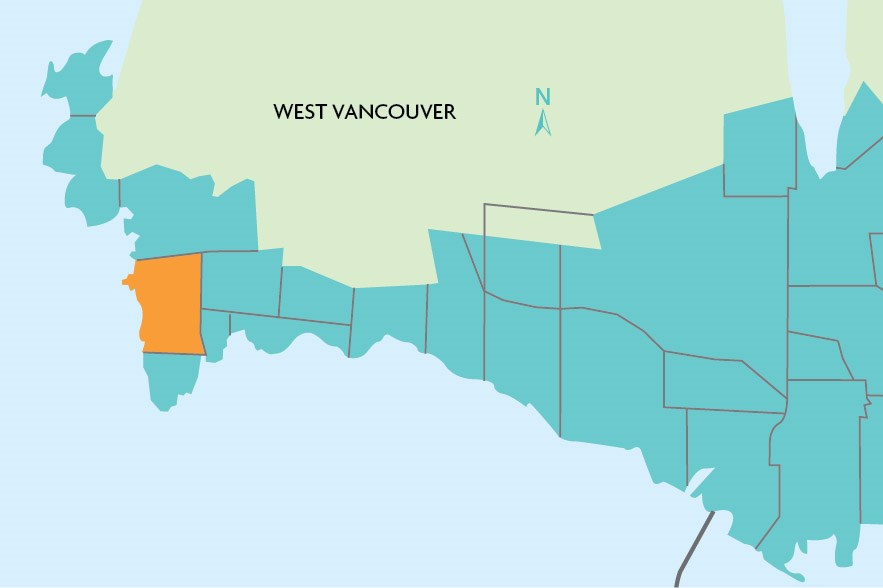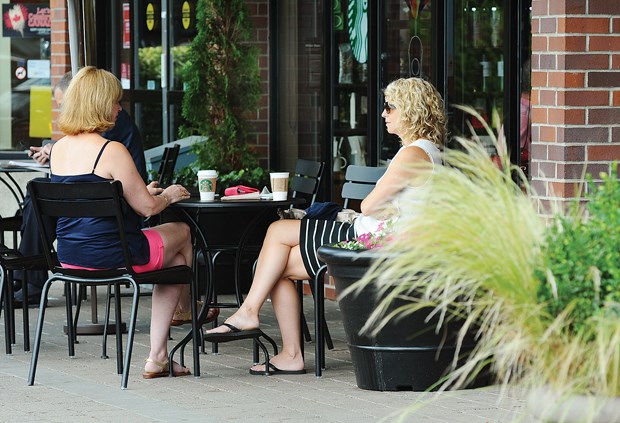For years it stood, its columns forming a familiar four-sided tribute to the Greek goddess Athena.
A piece of architectural folly, it may have seemed out of place nestled on the waterfront of the quaint neighbourhood of Caulfeild in West Vancouver, but many remember
“The Parthenon,” as it was called, a replica (not scale) of the ancient temple of the same name (the real one is located in Athens). The Caulfeild version was mainly caught in glimpses as it came in and out of view if one drove along Marine Drive.
Rumour has it the structure was built by the homeowner at the time, and he or his wife may have originally been from Greece. It was reportedly seen until the 1990s when suddenly it was no longer there.
Resident Barb Lunter doesn’t remember The Parthenon statue, but she would describe the neighbourhood of Caulfeild as having more of a British flavour than a Greek one. She compares it to the Cotswolds in England, a popular tourist destination known for its clusters of limestone cottages in a string of rural villages.
“We thought that it was just one of the most beautiful neighbourhoods in terms of feeling like you’re in the country, and yet you’re only seven minutes from Dundarave and 20 minutes from downtown, but you really get the sense that you’re far away,” says Lunter of her impression of the neighbourhood before she moved there 14 years ago.
Raised in Lynn Valley, Lunter moved to Dundarave when she got married then shuffled west to Caulfeild.
“It’s like the neighbourhoods that are described in the Huckleberry Finn book,” she notes, adding it’s not unusual to catch residents walking around carrying kayaks, or wearing gumboots or swim towels.
“For all the changes that have been happening in the world, this neighbourhood managed to stay like it was over a hundred years ago. It’s just the same, and it never changes and I think that’s why people love this neighbourhood.”
Her favourite memory is regularly taking her two kids to the waterfront wharf in Tiddly Cove over the years for swimming.
Originally known as Skunk Cove, Caulfeild Cove, with its inner beach stretch known as Tiddly Cove, served an early important function.
Because the waterfront from Cypress Creek to Lighthouse Park is so rugged and craggy, ships entering and leaving the harbour in the early days needed a local pilot to help guide them. Pilot boats would wait in Skunk Cove to escort ships in and out.

Many houses in the area are still centred around the cove, and Lunter says there’s still lots of activity coming in and out.
“There’s always something going on in the cove,” she notes.
Many property lots are considered estate-sized in Caulfeild, and there are plenty of trees and green space, but driving there can be a challenge thanks to a series of winding, one-way, narrow roads. Lunter admits this can be a problem for some, but she has lived in the area long enough that navigating and parking aren’t issues for her.
The homes in this area were originally built as summer cottages with plywood frames, single-pane windows, and no insulation. Lunter remembers how drafty her home was when she and her husband first moved in until the couple remodelled and later rebuilt.
Some homes in Caulfeild remain close to their original design, while others have been completely redone, but renovations are not a sure thing in this neighbourhood.
The Lower Caulfeild Advisory Committee is an extra layer of procedure homeowners must go through before getting approval for changes. Lower Caulfeild is a designated Heritage Conservation Area, for which the LCAC acts as an advisory board to the District of West Vancouver council and planning department. The committee makes recommendations to the district about permits for changes in this area.
“It’s good for the neighbourhood because it keeps our heritage feel here,” says Lunter, but admits it can be an extra hurdle for homeowners trying to make changes to their property.
Caulfeild’s loose boundaries start at Cypress Creek to the east just before Bayridge and hit water in the west just before Eagle Harbour northwest and Lighthouse Park in the southwest. The ocean forms a natural boundary to the south, while the Upper Levels Highway acts as the northern boundary just before Cypress Park.

As with all areas of the North Shore, Caulfeild was originally the territory of the Coast Salish people, including the Squamish Nation. As European settlers moved in and areas were pre-empted, Caulfeild eventually became a destination for summer cottagers.
According to the book Cottages to Community, by Francis Mansbridge, its current name came from settler Francis Caulfeild who was originally from England and purchased a large swath of property in 1899.
He then set out to develop a residential area that incorporated the surrounding natural features. His preference for following natural contours rather than the more common surveyors’ straight lines probably contributed to the neighbourhood’s current curvy maze of streets. Caulfeild returned to England in 1926 and died there in 1934, but not before donating 25 hectares for parks, as well as a site for St. Francis-in-the-Wood church.
Another early resident who recently made news again was Howard Martin, a developer who died in 1994.
According to a previous North Shore News story, Martin donated 10 acres of land in 1954 to establish Caulfeild elementary with the condition that the eastern end of the property be kept as forest for the kids to play in. Martin built homes around the school in the 1960s and ’70s, and was instrumental in bringing together the owners in a process that led to the 1978 approval of the development of the Caulfeild neighbourhood. In 2014, the West Vancouver Community Foundation was a recipient of $3.6 million from Martin’s estate, as part of a $27-million endowment to four different organizations.
Although residential now, at one time Caulfeild did host some industry. In the late 1800s, the Great Northern Cannery occupied a large waterfront property in Caulfeild. It operated until the 1960s when residents pushed for its closure partly due to the associated smell and noise. The area was bought by the federal government and replaced with a Department of Fisheries and Oceans laboratory that is still there today.
Marine Drive opened in 1915, and ferry rides brought visitors over from Vancouver, but there were still only about 50 homes in the area by the 1940s. However, the population grew to 2,700 by the mid-1970s, and a new subdivision was eventually added to the Caulfeild Plateau, just north of Lower Caulfeild, where 270 acres (110 hectares) were developed, according to Mansbridge’s book.
The subdivision helped boost the population, and in 1987 the Caulfeild Village Shopping Centre opened providing a local retail and commercial destination.
Contact Rosalind Duane at [email protected].



